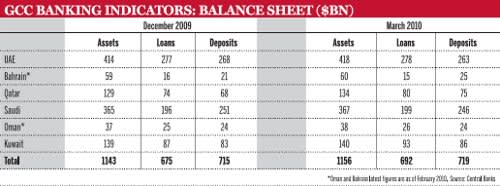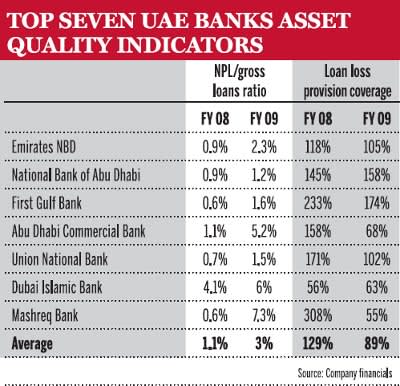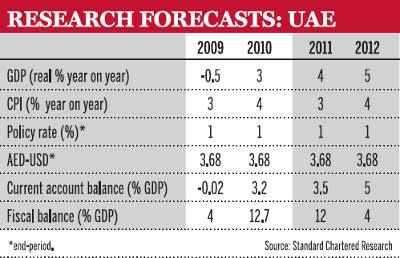Click here to view an edited video
There is perhaps no better example of the economic boom that preceded the global financial crisis than the story of Dubai. Having emerged from relative obscurity at the start of this century, Dubai's rapid economic development positively drew the world's attention to the Middle East, a region often associated with turbulence. Dubai, one of the seven emirates that comprise the United Arab Emirates, spearheaded the country's high economic growth that averaged 9% between 2003 and 2007. Construction and services were at the heart of Dubai's story. A plethora of cranes constructing high-rise buildings, land reclamation projects creating man-made islands and major Western service institutions opening offices symbolised the emirate's emergence.
However, an issue that received less attention at the time was how Dubai's boom was funded. The government-owned entities that were central to Dubai's development borrowed extensively on international capital markets and from banks, local and foreign. While the unprecedented boom had a profoundly positive impact on Dubai's banks, in that local banks were well-capitalised and highly profitable through mid-2008, an increasing concern was the growth of credit to the private sector in the UAE as a whole, which recorded year-on-year growth through 2008. This development raised the prospect of an increase in non-performing loans (NPLs). In fact, the UAE banking system's loans-to-deposits ratio exceeded 100%, the regulatory limit, by the end of 2007, according to an International Monetary Fund (IMF) working paper published in December 2009.
Near bursting point
The onset of the financial crisis in October 2008 greatly affected Dubai's banks and prompted the spectre of the emirate's bubble bursting. Local banks suffered from significant capital outflows, which had largely been speculative short-term funds; the result was liquidity pressures as banks had lent the funds out. A number of them ended up sitting on huge asset-to-deposit ratio gaps, with some as high as 150%, according to one leading economist. In addition, foreign financing for corporates dried up, which had the result of halting the emirate's real estate and construction sectors.
Within a short space of time, it appeared that Dubai had gone from being an economic miracle to being another victim of a crisis precipitated by the subprime mortgage market in the US. This change in image was further reinforced by stories of a mass exodus of foreign workers and expensive credit-funded cars dumped at airports as foreign citizens fled.
However, some say the global financial crisis has been positive for Dubai. "The global financial crisis can be interpreted as a good thing. In the boom years, the local economy had been growing at an incredibly high rate while the rules and regulations governing banking did not adequately reflect the rapid development that had taken place. We now have an opportunity to push for the right changes across the board, in order to create the right foundation for future growth and avoid the problems of today in the future," says Sameer Al Ansari, CEO of Shuaa Capital, the prominent Dubai-based investment bank.
Watch the videoCurrent climate in Dubai |
More food for thought
Still in the process of cleaning up their balance sheets following the crisis, Dubai's banks have since had to confront a challenge that lies closer to home. In November last year, Dubai World, the emirate's own investment company, proposed to delay repayment of its $26bn debt for six months; this raised the unnerving prospect of a government default similar to that experienced in Argentina in 2001. Dubai's case was further weakened by the emirate's apparent refusal to come to the aid of its troubled conglomerate. This led to an ostensible no-confidence vote in other state-owned entities, following rating agency Moody's decision to demote six other government-related entities to junk status, including the renowned ports operator DP World.
As was to be expected, Dubai's banking system was immediately put under the spotlight. Prior to the onset of the crisis, local banks' assets and profits increased sharply in 2007 and the capital adequacy ratio stood at 13.3% by 2008, above the regulated minimum of 10%. However, shortly after the Dubai World announcement, Standard & Poor's (S&P) cut the credit ratings of four Dubai-based banks - National Bank of Dubai, Dubai Islamic Bank, Mashreq Bank and Emirates Bank International - because of their high exposure to Dubai government entities.
Some respite did emerge. In mid-December last year, the Abu Dhabi government announced that it would provide $10bn to Dubai to repay Dubai World's $4.1bn Islamic bond (sukuk) that was due to mature that month. The remainder of the sum was to be used to keep Dubai World operating until it executed a restructuring deal with its creditors.
Abu Dhabi's assistance is seen as a positive signal in key quarters. "Dubai is going through a steep but positive learning curve. While the Dubai World issue has been a blow, it has shown the ability of the UAE federation to co-operate in times of difficulty. More importantly, the ties between Dubai and Abu Dhabi underline the importance of Dubai's role in growing the UAE's economy," says Marwan Ahmed Lutfi, deputy CEO of the Dubai International Financial Centre (DIFC) Authority, the body which develops policies and manages Dubai's iconic financial centre.

Dr Nasser Saidi, chief economist, DIFC Authority
Pacifying concerns
Lingering worries over Dubai's sovereign finances in the absence of a restructuring plan continued to adversely affect market confidence in the emirate. In February of this year it was revealed that the cost of insuring Dubai's debt had risen to its highest level since March 2009. Five-year credit default swaps jumped to 651 basis points, higher than the level seen in November following Dubai World's announcement. At that point, it seemed that only a definitive solution to the debt crisis would placate the situation.
A significant breakthrough only arrived in late March, courtesy of the Dubai government itself. It was announced that the emirate would provide $9.5bn to Dubai World, with its property arm, Nakheel, the main beneficiary. It emerged that holders of Nakheel's bonds would be paid on time and in full. Creditors, which included a number of major Western financial institutions, were assured of repayment, albeit with payments structured over a period of up to eight years, with a 2% spread offered in order to compensate for the delay.
Commenting on the restructuring deal in the local press, the DIFC's highly respected chief economist, Dr Nasser Saidi, claimed it would have a positive impact on the Gulf region's economy, due to a reduction in investor uncertainty and macroeconomic risk. Mr Saidi significantly noted the absence of 'haircuts' for creditors as boding well for lending prospects. Increased credit will provide the platform for Dubai's recovery and expansion in future years, according to Mr Saidi.
Talking to The Banker more than a month after the announcement, Mr Saidi remains positive. "The restructuring proposal for Dubai World's debt has removed a major cloud of uncertainty. Nakheel's troubles were a classic case of maturity mismatching, namely financing long-term projects through short-term bonds, which created rollover risk. It was an avoidable storm but the main thing is the lesson has been learned," he says.
Mr Saidi elaborates on what else needs to be learned. "The next lessons are about risk management, greater transparency and more centralised financial management. We are already seeing greater financial control at a centralised level through the department of finance, supreme fiscal committee and the debt management office. These developments should lead to better financial management."
Mr Saidi was quick to establish that investor worries about Dubai's debt were unwarranted in the first place. "It is important to appreciate the UAE's net foreign asset position. This country is a creditor to the rest of the world to the tune of approximately $450bn, which is in excess of 150% of gross domestic product (GDP). Therefore, doubts expressed about Dubai World's ability to come through this crisis are misplaced when considering that Dubai is an integral part of the UAE federation," he says.
The feeling among senior local bankers is that confidence is returning to the sector. "The restructuring deal is very important and serves as a positive signal from the government of Dubai that it takes the matter with the utmost seriousness. We have all seen the effect the international banking crisis has had on our economy, but the recent developments are going to restart Dubai's economic ascent," says Abdulaziz Al-Ghurair, CEO of Mashreq Bank, one of the local institutions believed to be highly exposed to Dubai's sovereign debt.
HSBC, one among a number of foreign players exposed to Dubai's debt obligations, also continues to believe in the region's economic prospects. "We are looking to emphasise the importance of the Middle East in the context of HSBC's global business. Last year, we took the decision to strip out the Middle East from Asia and report it as a region in its own right. This decision was driven by a macroeconomic view of the world, rather than a reaction to specific events," says David Dew, HSBC Amanah's outgoing deputy chief executive.
The restructuring plan's effect on local banking institutions was given a vote of approval from Moody's ratings agency in early April. "The proposed framework for the restructuring of Dubai World is unlikely to have direct negative rating implications for banks in the United Arab Emirates," the agency said in a statement.
All of this has been welcome news for Dubai's banking sector, particularly as last year was a cause of concern for local institutions. Lending slowed down as banks sought to preserve liquidity, provisioning took hold as banks anticipated losses and cost control measures were pervasive as banks sought to sustain profitability levels. In terms of profitability, UAE-listed banks' net earnings fell to Dh16bn ($4.36bn) over the first nine months of 2009, a 17% drop from the corresponding period in 2008. According to Shuaa Capital's UAE Vision 2010 report, loan-related provision expenses totalled Dh9.5bn during the first nine months of last year, a significant increase from the figure for the same period in 2008 of Dh2.5bn. Although official figures are not available, NPLs were estimated to have sharply increased between the end of 2008 and the end of 2009.
The outlook for 2010 has been mixed thus far. S&P believes that this year will be difficult for banks based in Gulf Co-operation Council (GCC) states, particularly those in Dubai and Kuwait. S&P cites the unfavourable economic conditions on profitability and asset quality for Dubai's banks. This point of view seems to contrast with the opinion of some notable banking figures. "The UAE continues to be vibrant; Dubai accounts for 60% of the economic activity in the UAE. For example, a lot of companies are still exporting from Dubai and the economy has been resilient in that no bankruptcies have happened in spite of the crisis. While things have slowed down in recent times, Dubai will continue to be the main business hub for the region, not just the UAE," says Hussain Al Qemzi, group CEO of Noor Islamic Bank, one of the UAE's most prominent sharia-compliant financial institutions.

GCC banking indicators: Balance sheet ($bn)
Standard Chartered's view
Possibly the greatest endorsement of Dubai's economic prospects comes from Standard Chartered, which is among a group of Western financial institutions known to be exposed to Dubai's debt problems. In spite of the bank's estimated $12bn exposure to the UAE as a whole, leading Standard Chartered officials continue to exude confidence. "Dubai's recent woes can be characterised as growing pains. We at Standard Chartered have placed firm faith in this region as can be demonstrated by our strategic decision to relocate our senior bank leader position and some of our global trading teams to Dubai from our London head office. We are part of a broader, arbitrage-like migration away from established Western centres to the UAE," says Dan Azzi, head of global markets for the Middle East, north Africa and Pakistan at Standard Chartered's Dubai office.
Shady Shaher, economist for the Middle East and north Africa at Standard Chartered, shares similar sentiments. "Despite the unwinding of the housing market bubble and Dubai's debt levels, some key areas are showing resilience and strength. Dubai is a global leader in logistics, being the third-largest re-export centre in the world. And this sector is booming. Retail activity is strong and so is the hospitality sector," she says.

Top seven UAE banks asset quality indicators

Research forecasts: UAE

GCC banking indicators: Loans/deposits ratio












